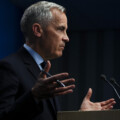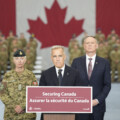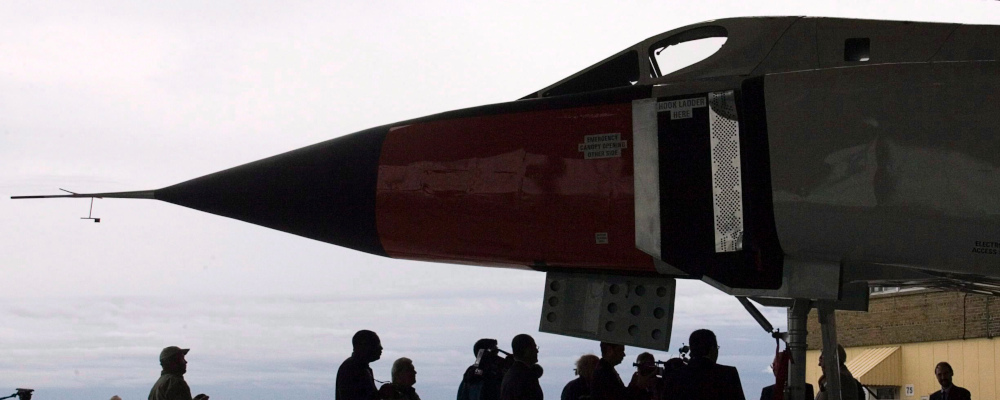This week marked a major anniversary in Canadian aviation and military history. Tuesday was the 64th anniversary of the Diefenbaker government’s controversial decision to cancel the Avro Arrow project. It’s a decision that has not only become the subject of popular folklore and even ongoing controversy, but its inherent tensions continue to play out in Canadian policy debates about defence policy and military procurement.
The Avro Arrow project launched in earnest in 1953. Although it’s hard to appreciate today when we’re regularly reminded of Canada’s low military spending and deteriorating military industrial base, the Canadian Air Force came out of the Second World War as the fourth largest among the Allies, and Canadian defence spending as a share of GDP was nearly 10 percent in the 1950s. Not only did we have a strong military track record during the World Wars, but as the Cold War was beginning to take shape, there was a strong sense that the country needed to maintain and even strengthen the country’s defence capacity.
Developed by domestic aircraft manufacturer Avro Canada, the Avro Arrow was conceptualized after the Royal Canadian Air Force (RCAF) sought a plane that could fly at Mach 2 speeds and reach higher altitudes. The promise of this program would demonstrate doubly that Canada was making strides in the aerospace and aviation industry, while also showing preparedness in the face of potential threats. “Our defences were ready” was something the Avro Arrow had come to represent.

The project’s rollout began in 1955. In those early years, the RCAF actually came close to selling the Avro to the U.K., but the 1957 Defence White Paper halted those plans. Test flights and productions were accelerated in response to a Moscow airshow that signalled the erstwhile Soviet Union would outnumber American bombers. The threat had become imminent.
Despite these developments, Canada’s Joint Intelligence Committee, formed in the postwar period and created to provide strategic assessments, was tasked in 1958 with the decision of whether to continue supporting the project or scupper it.
That was the same year that Canada signed the agreement with the U.S. to establish NORAD. The new alliance tilted in the direction of greater military integration between the two countries including with respect to equipment and procurement. At the same time, concerns about Soviet aircraft started to shift as it itself began to invest in other defence capacities—including ballistic missiles. The combination of these factors (as well as its rising fiscal cost) spelled doom for the Avro Arrow. The project was cancelled on February 20, 1959.
This was considered a setback for the aviation industry, including the loss of as many as 15,000 jobs. The RCAF purchased the McDonnell Voodoo jet from the United States Air Force as the successor to its aging aircrafts.
Prime Minister John Diefenbaker cited the diminished Soviet threat as the main reason for the Arrow’s cancellation. Alan Barnes, a former federal intelligence official, however, points to the project’s financial unsustainability as a key factor. He argues that the Diefenbaker government subordinated financial concerns because it didn’t want to be perceived as cutting military spending.

So was the tale of the Avro Arrow. Since then, Canada has relied on American suppliers for its military aircrafts. Last year’s purchase of F-35s is a prime example.
Canada’s dependence on foreign military suppliers remains the subject of debate. There have long been calls for the federal government to leverage military procurement to cultivate a stronger domestic industrial base. The Avro Arrow experience is sometimes even cited as rationale for such an approach. This debate continues to play out in the context of growing calls for Canada to boost its military spending to meet its NATO obligations.
Another modern-day similarity is the Department of National Defence’s lack of transparency—a subject that Hub contributor Richard Shimooka recently wrote about. In the case of Avro Arrow, we’re still learning the full story of the project and the decision to cancel it because there isn’t a process for systemically declassifying historical government records.
The upshot is that Avro Arrow isn’t simply a peculiar part of Canadian military and political history. The underlying debates behind the project and our efforts to understand it reflect important modern-day questions about the role and purpose of Canada’s defence policy.
Recommended for You

Falice Chin: The ‘wild and weird’ Calgary Stampede

‘Those deficits are almost surely going to rise’: Trevor Tombe on the fiscal challenges facing the Carney government

Trevor Tombe: How is Carney going to pay for his commitments? There are some tough choices ahead

Need to Know: Yahoo, Alberta! You’re doing something right




